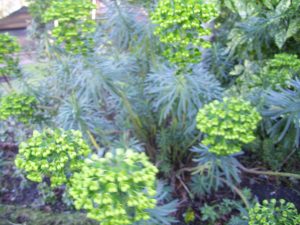Now the days are noticeably longer and in my garden, I can see bulbs and autumn-sown broad beans putting on a growth spurt in response to the day-length change. Shrubs and climbers are starting to grow new shoots, so now is the time to….
- Thin out bamboo clumps by removing thin and overcrowded canes – they will be ready to act as supports for beans later. Remove low side branches to expose the decorative stems. Limit spreading by digging to expose the rhizomes and sever with loppers below ground (not so easy in Crondall clay!)
- Cut back Campsis and Wisteria last year’s growth to two or three buds and remove tangled old wood to a side branch or to ground level.
- Prune late-flowering clematis to the lowest pair of strong buds about 30cm (1ft) from the ground.

Euphorbias can provide brilliant colour and texture from February onwards
- Prune back last year’s growth of Buddleja to a low framework of old wood.
- Trim winter-flowering heathers as the flowers fade.
In the kitchen garden
- Cut autumn-fruiting raspberries to the ground and tie in early-fruiters’ canes.
- Fertilise tree, bush and cane fruit. Use a high potash formula. I use weathered ash from my wood fire and compost for the raspberries.
- Put seed potatoes to ‘chit’ in trays or eggboxes, eye-end up, somewhere cool and light. In this area earlies can be planted out in early April and main crop two weeks later.
- Sow broad beans, tomatoes, leeks, peas and salad under cover; plant shallots and garlic in the ground outside.
Since February’s jobs include a lot of pruning, I thought a few notes on the principles might be helpful.
Apical or terminal buds secrete tiny quantities of chemicals that diffuse down the stem and inhibit the growth of lateral buds. This reduces competition. Removing the source of the chemicals by pruning, or grazing animals, stimulates the growth of side-shoots, e.g. spurs on apple trees, vigorous new growth on Buddleja and late flowering clematis.
So, if a plant flowers on new growth e.g. Buddleja or standard rose, pruning back last year’s growth stimulates growth of flowering shoots; but, if a plant flowers on last year’s growth like Hydrangea or Philadelphus, cut out some old wood to the ground to stimulate new growth, but leave last year’s growth unpruned.
Winter jasmine and Forsythia both flower on last year’s growth, but can be pruned after flowering because there is time to grow more.
There are other reasons for pruning: removal of diseased shoots/branches back to healthy tissue, keeping an open structure where branches do not rub or shade each other, and, to restrict shape or size as with hedges.
What’s on in February
12th-14th RHS London Early Spring Plant Fair – see RHS.org.uk for details
Sir Harold Hillier Garden, Ampfield, Romsey for winter shrubs
18th Brandy Mount House, Alresford and the Down House, Itchen Abbas for Snowdrops
25th Chawton House Library, near Alton
The last three are open on those days for the National Gardens Scheme for charity but are open at other times as well.
10th February is when the Church Crookham Garden Society trading shed opens again for members. Details on this website. The January advice can be found on the website as well. See Archives.

